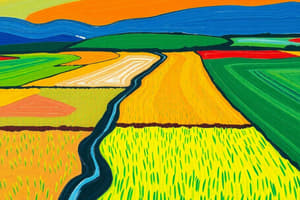Podcast
Questions and Answers
What is the primary purpose of cultivating the soil?
What is the primary purpose of cultivating the soil?
- Controlling weeds and pests
- Improving soil drainage
- Encouraging root growth
- All of the above (correct)
Reduced or no-tillage farming practices can have a negative impact on soil carbon levels.
Reduced or no-tillage farming practices can have a negative impact on soil carbon levels.
False (B)
What is the recommended depth for sowing seeds?
What is the recommended depth for sowing seeds?
1.5 to 2 inches
Which irrigation method is considered the most effective for delivering water and nutrients to crops?
Which irrigation method is considered the most effective for delivering water and nutrients to crops?
The application of ______, ______, and ______ can enrich soil nutrient content.
The application of ______, ______, and ______ can enrich soil nutrient content.
What is the key factor that determines the irrigation needs of crops?
What is the key factor that determines the irrigation needs of crops?
Conventional tillage is a practice where the soil is not disturbed before planting.
Conventional tillage is a practice where the soil is not disturbed before planting.
What are some methods used to control weeds?
What are some methods used to control weeds?
What is the main drawback of manual weeding?
What is the main drawback of manual weeding?
Selective herbicides only harm the weeds, leaving the crops unaffected.
Selective herbicides only harm the weeds, leaving the crops unaffected.
Which of these is NOT a type of pesticide?
Which of these is NOT a type of pesticide?
What is an eco-friendly approach to controlling pests and diseases?
What is an eco-friendly approach to controlling pests and diseases?
Climbing plants like bitter gourd, squash, and string beans require ______ for support.
Climbing plants like bitter gourd, squash, and string beans require ______ for support.
Flashcards
Cultivation
Cultivation
Stirring the soil to control weeds, pests, and improve root aeration.
Conventional tillage
Conventional tillage
A method of soil cultivation that involves plowing and harrowing.
Reduced/No-tillage
Reduced/No-tillage
Soil cultivation methods minimizing soil disturbance, improving soil carbon.
Seed sowing
Seed sowing
Signup and view all the flashcards
Planting seedlings
Planting seedlings
Signup and view all the flashcards
Seed quality
Seed quality
Signup and view all the flashcards
Seedling health
Seedling health
Signup and view all the flashcards
Sowing depth
Sowing depth
Signup and view all the flashcards
Spacing
Spacing
Signup and view all the flashcards
Irrigation
Irrigation
Signup and view all the flashcards
Manual irrigation
Manual irrigation
Signup and view all the flashcards
Drip irrigation
Drip irrigation
Signup and view all the flashcards
Sprinkler irrigation
Sprinkler irrigation
Signup and view all the flashcards
Fertilizer application
Fertilizer application
Signup and view all the flashcards
Soil nutrients
Soil nutrients
Signup and view all the flashcards
Fertilizers
Fertilizers
Signup and view all the flashcards
Manures
Manures
Signup and view all the flashcards
Compost
Compost
Signup and view all the flashcards
Scattering
Scattering
Signup and view all the flashcards
Mixing with soil
Mixing with soil
Signup and view all the flashcards
Weed Control
Weed Control
Signup and view all the flashcards
Hand Weeding
Hand Weeding
Signup and view all the flashcards
Mechanical Weeding
Mechanical Weeding
Signup and view all the flashcards
Chemical Weeding
Chemical Weeding
Signup and view all the flashcards
Selective Herbicide
Selective Herbicide
Signup and view all the flashcards
Non-selective Herbicide
Non-selective Herbicide
Signup and view all the flashcards
Pest Control
Pest Control
Signup and view all the flashcards
Pesticide
Pesticide
Signup and view all the flashcards
Herbicide
Herbicide
Signup and view all the flashcards
Insecticide
Insecticide
Signup and view all the flashcards
Fungicide
Fungicide
Signup and view all the flashcards
Molluscicides
Molluscicides
Signup and view all the flashcards
Rodenticides
Rodenticides
Signup and view all the flashcards
Eco-friendly Pest Control
Eco-friendly Pest Control
Signup and view all the flashcards
Organic Pesticides
Organic Pesticides
Signup and view all the flashcards
Beneficial Organisms
Beneficial Organisms
Signup and view all the flashcards
Support for Climbing Plants
Support for Climbing Plants
Signup and view all the flashcards
Trellis
Trellis
Signup and view all the flashcards
Climbing Plants
Climbing Plants
Signup and view all the flashcards
Bitter Gourd
Bitter Gourd
Signup and view all the flashcards
Squash
Squash
Signup and view all the flashcards
String Beans
String Beans
Signup and view all the flashcards
Study Notes
Crop Care and Maintenance Practices
-
Cultivation:
- The first stage of crop production involves soil stirring (e.g., plowing, harrowing).
- Effective for weed and pest control.
- Loosens soil, improving root aeration.
- Conventional tillage is a common method.
- Reduced or no-tillage can increase soil carbon levels, benefiting soil health and yields.
-
Seed Sowing/Planting Seedlings:
- High-quality seeds/seedlings are essential.
- Seeds should be planted at a depth of 1.5 to 2 inches to ensure proper moisture.
- Proper spacing is critical for optimal plant growth.
-
Irrigation:
- Crops need water, especially during droughts.
- Water requirements vary based on crop type.
- Irrigation methods include manual, drip, and sprinkler.
- Manual irrigation is labor-intensive and time-consuming.
- Drip irrigation is efficient, delivering water and nutrients directly to plants.
- Sprinkler irrigation uses spray, often advantageous with water scarcity.
- Soil and plant factors impact irrigation needs.
-
Fertilizer Application:
- Nutrient-deficient soil needs enrichment through fertilizers, manures, or compost.
- Fertilizer application methods include scattering or mixing with the soil before planting.
Studying That Suits You
Use AI to generate personalized quizzes and flashcards to suit your learning preferences.




